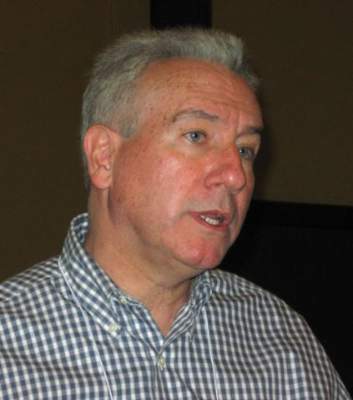User login
Major new clinical guidelines for rheumatoid arthritis and spondyloarthritis will be presented at the annual meeting of the American College of Rheumatology Nov. 15-19, while other sessions will examine aspects of recently published guidelines on polymyalgia rheumatica, gout, and lupus nephritis.
The ACR’s new RA guidelines, which will include recommendations on the use of nonbiologic and biologic disease-modifying agents, as well as corticosteroids, will be presented Sunday, Nov. 16. Draft axial spondyloarthritis guidelines, which will also address the management of patients with ankylosing spondylitis, will be discussed the same day.
With the ACR’s gout guidelines, (part 1 and part 2) published in 2012, “some controversial aspects of have emerged,” said Dr. Chester V. Oddis, chair of the meeting’s planning subcommittee. Dr. Oddis highlighted a Monday, Nov. 17, session that will specifically address components of the gout recommendations that have generated concern.
Also on Monday, weaknesses of current lupus nephritis recommendations will be hashed out in a session devoted to helping clinicians recognize some of their pitfalls. Key areas of discussion will include the role of rituximab and the problem of steroid use in this difficult-to-treat patient group.
Dr. Oddis, professor of medicine in the division of rheumatology and clinical immunology at the University of Pittsburgh, pointed to certain other sessions and presentations on RA during the 5-day meeting as especially compelling.
Morbidity and mortality features in RA will be covered in two presentations at the plenary session on Sunday. Dr. Oddis advised clinicians to “stay tuned” for results from a Dutch study that evaluated treat-to-target approaches in a cohort of more than 500 RA patients. Investigators found survival rates to be comparable with those of the general population after 10 years of treat to target, regardless of medications used. Tight control had more bearing on survival than did any particular course of treatment, with no significant differences seen between the four treatment strategies studied.
Also on Sunday, other key mortality findings will be discussed from a long-term, prospective, cohort study of 121,700 women that found that those diagnosed with RA over 34 years of follow-up (n = 960) had double the risk of death from any cause, compared with women without RA. Respiratory mortality accounted for 16% of deaths among RA patients, suggesting a little-explored cause of death, and women with RA were significantly more likely to die from cardiovascular disease and cancer than were those without RA, the study found.
The comparative effectiveness and harms of biologics are a hot topic in RA, and a Monday session will review findings from registries and direct comparator trials, offering clinicians suggestions on how to best learn from the data.
Dr. Oddis also highlighted a Tuesday session on the epidemiology of cardiovascular risk in RA and clinical CV risk management in patients with RA. The aim, he said, is to demonstrate “how we can best develop a rational approach to assessing this in our practices.”
Major new clinical guidelines for rheumatoid arthritis and spondyloarthritis will be presented at the annual meeting of the American College of Rheumatology Nov. 15-19, while other sessions will examine aspects of recently published guidelines on polymyalgia rheumatica, gout, and lupus nephritis.
The ACR’s new RA guidelines, which will include recommendations on the use of nonbiologic and biologic disease-modifying agents, as well as corticosteroids, will be presented Sunday, Nov. 16. Draft axial spondyloarthritis guidelines, which will also address the management of patients with ankylosing spondylitis, will be discussed the same day.
With the ACR’s gout guidelines, (part 1 and part 2) published in 2012, “some controversial aspects of have emerged,” said Dr. Chester V. Oddis, chair of the meeting’s planning subcommittee. Dr. Oddis highlighted a Monday, Nov. 17, session that will specifically address components of the gout recommendations that have generated concern.
Also on Monday, weaknesses of current lupus nephritis recommendations will be hashed out in a session devoted to helping clinicians recognize some of their pitfalls. Key areas of discussion will include the role of rituximab and the problem of steroid use in this difficult-to-treat patient group.
Dr. Oddis, professor of medicine in the division of rheumatology and clinical immunology at the University of Pittsburgh, pointed to certain other sessions and presentations on RA during the 5-day meeting as especially compelling.
Morbidity and mortality features in RA will be covered in two presentations at the plenary session on Sunday. Dr. Oddis advised clinicians to “stay tuned” for results from a Dutch study that evaluated treat-to-target approaches in a cohort of more than 500 RA patients. Investigators found survival rates to be comparable with those of the general population after 10 years of treat to target, regardless of medications used. Tight control had more bearing on survival than did any particular course of treatment, with no significant differences seen between the four treatment strategies studied.
Also on Sunday, other key mortality findings will be discussed from a long-term, prospective, cohort study of 121,700 women that found that those diagnosed with RA over 34 years of follow-up (n = 960) had double the risk of death from any cause, compared with women without RA. Respiratory mortality accounted for 16% of deaths among RA patients, suggesting a little-explored cause of death, and women with RA were significantly more likely to die from cardiovascular disease and cancer than were those without RA, the study found.
The comparative effectiveness and harms of biologics are a hot topic in RA, and a Monday session will review findings from registries and direct comparator trials, offering clinicians suggestions on how to best learn from the data.
Dr. Oddis also highlighted a Tuesday session on the epidemiology of cardiovascular risk in RA and clinical CV risk management in patients with RA. The aim, he said, is to demonstrate “how we can best develop a rational approach to assessing this in our practices.”
Major new clinical guidelines for rheumatoid arthritis and spondyloarthritis will be presented at the annual meeting of the American College of Rheumatology Nov. 15-19, while other sessions will examine aspects of recently published guidelines on polymyalgia rheumatica, gout, and lupus nephritis.
The ACR’s new RA guidelines, which will include recommendations on the use of nonbiologic and biologic disease-modifying agents, as well as corticosteroids, will be presented Sunday, Nov. 16. Draft axial spondyloarthritis guidelines, which will also address the management of patients with ankylosing spondylitis, will be discussed the same day.
With the ACR’s gout guidelines, (part 1 and part 2) published in 2012, “some controversial aspects of have emerged,” said Dr. Chester V. Oddis, chair of the meeting’s planning subcommittee. Dr. Oddis highlighted a Monday, Nov. 17, session that will specifically address components of the gout recommendations that have generated concern.
Also on Monday, weaknesses of current lupus nephritis recommendations will be hashed out in a session devoted to helping clinicians recognize some of their pitfalls. Key areas of discussion will include the role of rituximab and the problem of steroid use in this difficult-to-treat patient group.
Dr. Oddis, professor of medicine in the division of rheumatology and clinical immunology at the University of Pittsburgh, pointed to certain other sessions and presentations on RA during the 5-day meeting as especially compelling.
Morbidity and mortality features in RA will be covered in two presentations at the plenary session on Sunday. Dr. Oddis advised clinicians to “stay tuned” for results from a Dutch study that evaluated treat-to-target approaches in a cohort of more than 500 RA patients. Investigators found survival rates to be comparable with those of the general population after 10 years of treat to target, regardless of medications used. Tight control had more bearing on survival than did any particular course of treatment, with no significant differences seen between the four treatment strategies studied.
Also on Sunday, other key mortality findings will be discussed from a long-term, prospective, cohort study of 121,700 women that found that those diagnosed with RA over 34 years of follow-up (n = 960) had double the risk of death from any cause, compared with women without RA. Respiratory mortality accounted for 16% of deaths among RA patients, suggesting a little-explored cause of death, and women with RA were significantly more likely to die from cardiovascular disease and cancer than were those without RA, the study found.
The comparative effectiveness and harms of biologics are a hot topic in RA, and a Monday session will review findings from registries and direct comparator trials, offering clinicians suggestions on how to best learn from the data.
Dr. Oddis also highlighted a Tuesday session on the epidemiology of cardiovascular risk in RA and clinical CV risk management in patients with RA. The aim, he said, is to demonstrate “how we can best develop a rational approach to assessing this in our practices.”

